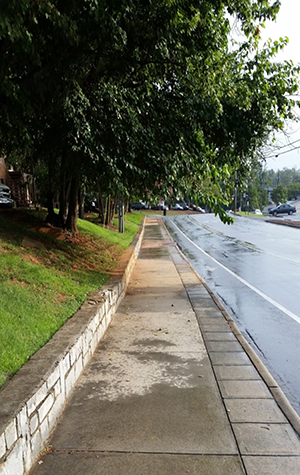Putting Numbers to Stormwater and Other Benefits of Atlanta's Urban Forest
-

- Photo courtesy of Eric Kuehler
In Atlanta, affectionately known as “the city in a forest,” tree canopy covers a little over 47 percent of the land within the city limits. In addition to capturing and filtering stormwater runoff, Atlanta’s urban forest provides its residents additional quality-of-life benefits such as energy conservation, air pollution removal, and carbon sequestration.
The City of Atlanta’s Department of Watershed Management (DWM) is interested in conserving and improving forest resources, in part, by implementing green infrastructure (GI) as a primary strategy to help control flooding and improve water quality. Guided by the Green Infrastructure Strategic Action Plan adopted in 2017, DWM is advancing GI across city departments to strengthen the resilience of Atlanta’s watersheds and communities in the face of rapid growth and climate change. The strategic plan quantified new GI tree planting based on research studies, but to advance the plan, DWM needed a method to similarly quantify the value of existing forests. In 2018, DWM partnered with the USDA Forest Service to evaluate the benefits that Atlanta’s urban forest provides, not only in terms of stormwater control but also for the co-benefits of energy conservation, air pollution removal, and carbon sequestration.
The Forest Service conducted an urban forest assessment in Atlanta between 2014 and 2015 using i-Tree Eco. Researchers established 443 randomly located 1/10-acre plots within city limits, and inventoried all trees within the plot boundary greater than 3 inches in diameter at breast height. i-Tree Eco estimated that there were about 3.7 million trees in the city (approximately 43 trees per acre) and that 235 square miles of leaf surface area covered the 134 square-mile city, roughly 76,400 square feet of leaf area per acre of land. The most common tree species found were loblolly pine (18 percent), sweetgum (11 percent), and water oak (7 percent). Having so many pine trees is a benefit to Atlanta for stormwater mitigation because pines typically have greater leaf surface area than deciduous trees and keep their foliage year-round, so they can retain more rainfall over the course of a year.
From estimated leaf surface area, researchers calculated that Atlanta’s urban forest retains approximately 32 million gallons of rainfall every time it rains. Using 2013 meteorological data from the local international airport, they used i-Tree Eco to calculate that leaf area also intercepted 3.2 billion gallons of rainfall, or about 2 percent of the total rain that fell on Atlanta that year. The model also estimated that the trees transpired almost 10 billion gallons of water from the soil (or 6 percent of the total rainfall), allowing for more water storage between rainfall events.
In addition, they estimated that every year Atlanta’s urban forest:
- removes 1,200 tons of air pollutants (ozone, NO2, SO2, PM2.5, CO), valued at $9 million in reduced incidences of adverse health effects;
- stores 1.3 million tons of carbon in its wood fiber (valued at $91 million);
- sequesters 45,000 tons of carbon ($3.2 million); and
- through direct shading and blocking winter winds, produces $13.5 million in energy savings, reducing carbon emissions by 23,000 tons (1.7 million).
DWM has completed 10 Watershed Improvement Plans (WIPs) to study and understand the condition of each of the City’s watersheds and develop projects that target water quality improvements and watershed health. WIPs identify potential engineered stormwater and GI projects, model cumulative benefits of projects at the watershed level, and score projects individually based on triple bottom line (environmental, social, and economic) criteria. Segregating the Forest Service urban forest assessment dataset by watershed, the DVM/Forest Service team was able to run i-Tree Eco assessments for each of the watersheds in Atlanta. DWM could now apply the i-Tree Eco model at the watershed scale to calculate the collective value of existing urban forest.
DWM was also interested in the value of the City’s publicly owned and protected forest land that was not included in the urban forest calculations. The City of Atlanta owns and maintains 1,920 acres of greenways, which are intact remnant forests, and 1,315 acres of naturally forested preserves as city parks. Using data from forested plots in Atlanta, i-Tree Eco was used to estimate stormwater benefits of preserved, undeveloped forest cover (vs. scattered trees on residential or commercial land) on a per acre basis. With that, DWM calculated that city greenways intercepted 151 million gallons of rainfall and transpired 304 million gallons annually, while the naturally forested parks intercepted 104 million gallons of rain and transpired 208 million gallons of water from the soil per year. These numbers help DWM track the benefits of new acquisitions and justify preserving existing forested tracts of land as part of its natural GI network.
A city’s urban forest provides substantial environmental and economic benefits. Specifically, it delivers quantifiable stormwater benefits by reducing runoff volume through rainfall interception and transpiring water out of the soil. Using an assessment tool like i-Tree Eco, Atlanta can quantify the value of its natural resources and demonstrate the benefits vs. costs of acquiring and preserving city-owned forests to help manage stormwater runoff and provide co-benefits more strategically and economically.
Feb 04, 2020



